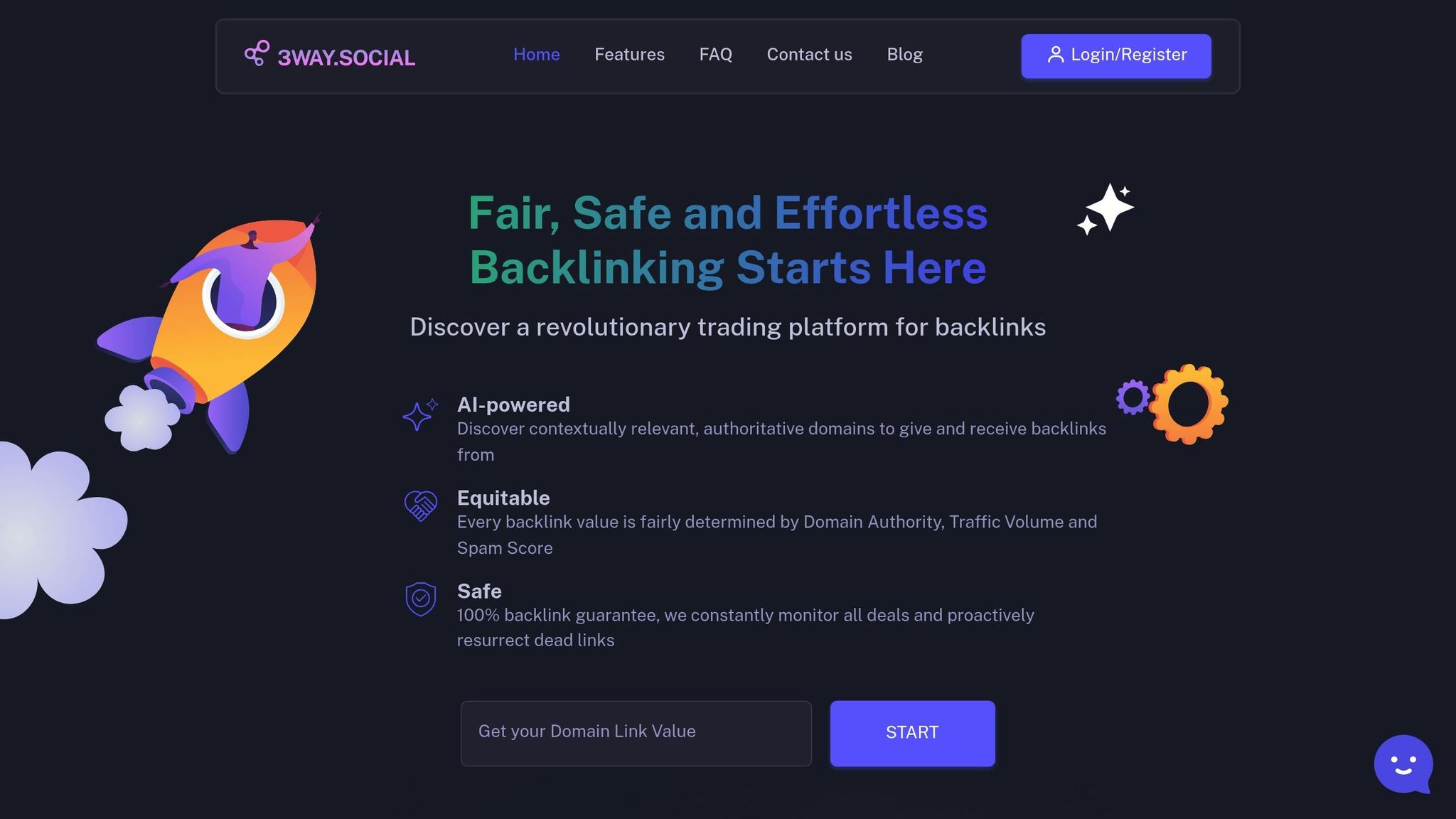Last Updated on June 30, 2025 by Becky Halls
Competitor backlink analysis is the process of studying the backlinks of websites competing with yours to find opportunities to improve your own SEO. Backlinks are links from other websites to yours, and they signal to search engines that your content is valuable. By understanding where your competitors get their backlinks, you can identify high-quality sites to target for your link-building efforts.
Why It Matters:
- Boost Rankings: Backlinks are one of the top-ranking factors for search engines like Google.
- Find Opportunities: If a site links to your competitor, they might link to you too.
- Improve Strategy: Focus on high-value backlinks that drive authority and traffic.
Key Metrics to Focus On:
- Domain Authority (DA): Measures a website’s credibility.
- Relevance: Links from sites in your niche are more valuable.
- Traffic: Backlinks from high-traffic sites can drive visitors to your site.
- Diversity: A balanced mix of backlinks (dofollow, nofollow, etc.) strengthens your profile.
Tools to Use:
- Ahrefs: Massive backlink database and detailed analysis.
- Semrush: Comprehensive SEO suite with backlink insights.
- Moz: Known for Domain Authority and beginner-friendly features.
- Majestic: Focuses on link quality metrics like Trust Flow.
- SE Ranking: Affordable, all-in-one SEO tool.
Steps to Analyze Competitor Backlinks:
- Identify Competitors: Find websites ranking for your target keywords.
- Gather Backlink Data: Use tools to export competitor backlink profiles.
- Evaluate Links: Focus on authority, relevance, and placement.
- Find Gaps: Spot opportunities where competitors have links, but you don’t.
- Prioritize Outreach: Target high-authority and relevant domains.
Proven Strategies:
- Email Outreach: Request links from sites linking to your competitors.
- Broken Link Building: Replace broken links with your content.
- Skyscraper Technique: Create better versions of popular competitor content.
Competitor backlink analysis is a powerful way to improve your SEO, uncover link opportunities, and build a stronger backlink profile. Start today by analyzing your competitors and focusing on quality over quantity.
How To Do A Competitor Backlink Analysis Using Free & Paid Tools (A Step By Step Guide)
Key Concepts in Backlink Analysis
Before jumping into competitor backlink analysis, it’s important to grasp the core ideas and metrics that help determine which competitor backlinks are worth pursuing.
Understanding Backlink Metrics
Backlink metrics provide a way to assess the strength of a website’s link profile by focusing on the quality and authority of its backlinks. Some of the key metrics to consider are domain authority, page authority, relevance, traffic, trustworthiness, and link placement.
- Domain and page authority measure a site’s credibility and the influence of its links. Links from high-authority domains carry more weight than those from lesser-known or newer sites.
“And the most important metrics in determining the authority of a given link are the number of keyword rankings that the domain you are getting the link from has, as well as the amount of estimated organic traffic the domain gets from those rankings.”
– Miguel Salcido, CEO & Founder at Organic Media Group
- Relevance is another vital factor. A backlink from a site in your industry often holds more value than a link from an unrelated domain.
“A linking site that’s from the same or similar industry as yours will hold more value than a link from an unrelated industry. Relevant niche shows contextual relevancy and trustworthiness.”
– Kimberley McConnery, Director of Link Building Operations at Sure Oak
- Traffic, trustworthiness, and link placement also influence a backlink’s value. For example, links embedded naturally within content tend to carry more authority than those shoved into less noticeable parts of a page.
Understanding these metrics allows you to evaluate how different links contribute to a site’s overall SEO performance.
Different Types of Links
Backlinks come in various forms, and each type impacts SEO differently. Recognizing these link types in competitor profiles can shape a smarter link-building strategy.
- Dofollow links are the most sought-after because they pass authority (or “link juice”) from the linking site to your own, directly boosting rankings and credibility.
“A dofollow link is a hyperlink that allows search engines to pass authority from one domain to another. In other words, when a site links to you with a dofollow attribute, it shares some of its ‘link juice.'”
– Rhino Rank team
- Nofollow links include the
rel="nofollow"attribute, signaling search engines not to pass authority. While they don’t directly enhance rankings, they can still drive traffic and increase visibility. - Sponsored links use the
rel="sponsored"attribute to indicate paid placements. These don’t pass authority but can still generate traffic and boost brand awareness. - UGC (User-Generated Content) links come with the
rel="ugc"attribute and are often found in comments, forums, or reviews. While they don’t pass traditional link equity, they reflect active engagement around your content.
| Link Type | SEO Value | HTML Attribute |
|---|---|---|
| Dofollow | High | None |
| Nofollow | Limited | rel=”nofollow” |
| Sponsored | None | rel=”sponsored” |
| UGC | Minimal | rel=”ugc” |
A balanced mix of these link types contributes to a healthier and more natural backlink profile.
Why Link Diversity Matters
A strong backlink profile isn’t just about quantity – it’s about variety. Search engines favor profiles that include a mix of link types, anchor texts, and source domains, as this suggests the links were earned organically.
- Anchor text diversity is crucial. A natural profile includes branded anchors (like your company name), generic phrases (“click here” or “read more”), and keyword-rich anchors that describe your content accurately. Overusing keyword-heavy anchors can appear manipulative and harm your rankings.
- Source diversity means getting backlinks from a wide range of websites, such as news outlets, industry blogs, educational sites, and directories. Sites with links from varied sources often perform better in organic search results.
Regular backlink audits are essential for spotting imbalances or weaknesses in your link profile. This ensures your link-building strategy stays effective and sustainable over time.
Tools for Competitor Backlink Analysis
When it comes to competitor backlink analysis, having the right tool can make all the difference. The key is to choose one that aligns with your SEO goals and provides accurate, actionable insights.
Best Tools for Backlink Analysis
The market offers a variety of tools, each with its own strengths tailored to different aspects of backlink research. Here’s a breakdown of some of the top options:
Ahrefs boasts a massive database of 35 trillion historical backlinks and a web crawler that scans over 6 billion pages daily. Covering 218 million domains, it’s a go-to for uncovering unique backlink opportunities and analyzing competitor link profiles in detail.
Semrush offers a robust database of over 43 trillion backlinks, along with integrated insights into content, keywords, and advertising. Its backlink audit tool is especially helpful for detecting toxic links and understanding link quality, making it easier to dissect competitor strategies.
Moz Link Explorer combines backlink analysis with educational resources. Known for its Domain Authority metric, a widely recognized standard in SEO, Moz is an excellent choice for those looking to communicate link value effectively. It’s ranked as the third-best link analysis tool in the market.
Majestic focuses on link quality with its Trust Flow and Citation Flow metrics. Despite its somewhat dated interface, Majestic’s database of over 21 trillion backlinks provides valuable insights for evaluating links from multiple perspectives.
SE Ranking offers a well-rounded platform that includes backlink analysis, rank tracking, and technical SEO audits. Starting at $65 per month, it provides access to 2.9 trillion indexed backlinks, making it a budget-friendly option for small businesses and startups.
Each tool brings something unique to the table. Ahrefs excels at finding backlink opportunities, while Semrush provides a broader suite of features for analyzing competitor strategies. Your choice will depend on your specific needs and priorities.
How to Choose the Right Tool
Choosing the best backlink analysis tool comes down to understanding your business goals and SEO objectives. Here are some key factors to consider:
Budget is often a deciding factor. Prices range from affordable options like Ubersuggest at $12 per month to more premium solutions like Pitchbox, which can cost between $550 and $1,500 per month with annual commitments.
| Tool | Starting Price | Key Strengths | Best For |
|---|---|---|---|
| Ahrefs | $99/month | Comprehensive backlink database, accurate DR scores | Detailed competitor analysis |
| Semrush | $139.95/month | All-in-one marketing suite | Full-service SEO teams |
| Moz Pro | $99/month | Educational resources, Domain Authority | Beginners and client education |
| Majestic | $49.99/month | Historical data, Trust Flow metrics | Budget-conscious deep analysis |
| SE Ranking | $65/month | Integrated platform | Small businesses and startups |
Data accuracy is critical. The tool you choose should offer reliable and detailed information about backlink profiles. For example, Ahrefs and Semrush are both praised for their ability to analyze dofollow vs. nofollow links, anchor text usage, and new vs. lost domains.
Ease of use is another important factor. A user-friendly interface can save time and streamline your workflow. Tools like Moz Pro are great for beginners, while Ahrefs offers advanced features that may take more time to master.
Scalability matters if you expect your business to grow. Look for tools that can handle increasing amounts of data without requiring expensive upgrades. Features like API access and customizable reports are especially useful for enterprise-level users.
Lastly, trial periods can be invaluable. Many platforms offer free trials or limited free versions, giving you the chance to test their features and see how well they fit into your workflow.
The right tool depends on your goals. If you’re focused on finding backlink gaps, Ahrefs is a strong choice. For a more comprehensive marketing suite, Semrush is worth considering. And for those on a tighter budget, SE Ranking and Majestic offer solid functionality at lower costs.
sbb-itb-88880ed
Step-by-Step Process for Competitor Backlink Analysis
Taking a structured approach can help you uncover link opportunities more effectively.
Finding Your SEO Competitors
Your SEO competitors aren’t always the same as your business competitors. They’re the ones ranking for the keywords you’re targeting.
Start with manual keyword searches. Take your primary keywords and search for them on Google. Make a list of websites that consistently show up on the first page for those terms.
“Your direct competitors will be websites that rank high on page one (on Google or other search engines) for the same keywords you’re targeting.”
Use SEO tools to dig deeper. While manual searches are a good start, tools like Semrush and Ahrefs can uncover competitors you might miss. These tools highlight domains ranking for similar keywords, giving you a fuller picture.
Think beyond the obvious. Industry expert Adeline Cooper advises:
“Most people skip this and end up comparing apples to spaceships. Use SEMrush or Ahrefs to find sites actually ranking for your target keywords. Pro tip: check ‘Also rank for’ sections – those sneaky rivals flying under the radar are gold.”
Check directories and resource pages. Industry directories often link to multiple competitors, helping you spot players you may have overlooked.
Aim to identify 5-10 strong competitors that frequently rank for your target keywords. This will give you enough data to work with while keeping your analysis manageable.
Once you’ve pinpointed your competitors, the next step is to gather and assess their backlink data.
Collecting and Analyzing Backlink Data
This phase is all about exporting data and evaluating the quality of links.
Export backlink data from your chosen tool. SEO platforms allow you to download reports showing linking domains, anchor text, link types, and authority metrics. Look at both domain-level and page-level data – domain-level provides a broad view of link authority, while page-level shows which specific pages attract links.
Evaluate link quality. Focus on three factors: authority, relevance, and natural placement. High-quality backlinks come from trusted, relevant websites. Avoid links from spammy or irrelevant sources.
Monitor real-time strategies and find broken link opportunities. Keep an eye on when competitors get mentions without links. These instances can be opportunities for your brand to secure coverage from the same sources .
With this data in hand, you can start identifying trends and gaps that reveal opportunities.
Finding Trends and Performing Gap Analysis
Spotting patterns in competitor backlinks can help refine your outreach strategy.
Use link intersect tools. These tools identify websites that link to multiple competitors but not to you. Targeting these sites can lead to high-probability link opportunities.
Analyze content types and anchor text strategies. Look at what kinds of content consistently earn links in your niche. Review anchor text usage, seasonal trends, and media relationships to uncover untapped opportunities.
Map competitor content to link sources. Identify which pieces of competitor content attract the most high-quality links. This can point to content gaps where you can create better resources.
Prioritizing High-Value Backlink Opportunities
The insights from your analysis should help you focus on backlinks that offer the greatest SEO benefits.
Authority and relevance are key. High-authority backlinks from niche-relevant sources carry the most weight.
“Backlinks remain the best indicator to Google and other search engines that a webpage is considered important by internet users. Links can be compared to votes, only when it comes to backlinks votes are not equal. The more relevance and authority a website has, the more weight the vote gets.”
Editorial backlinks should be a priority. Links that appear naturally within content are more valuable than those in directories or footers.
Target government and educational domains. Links from .gov and .edu sites are often seen as highly credible by search engines.
Consider traffic potential. Beyond authority, check if referring domains have steady, high-quality traffic that aligns with your audience.
| Priority Factor | What to Look For | Impact Level |
|---|---|---|
| Domain Authority | High DA, Trust Flow scores | High |
| Content Relevance | Industry alignment, topic match | Critical |
| Link Placement | Contextual links over footers | Medium |
| Traffic Potential | Organic traffic, audience overlap | High |
Quality over quantity.
“Sometimes, it can take only one website to tip the balance of the scales and make Google sit up and pay attention. It has to be a very authoritative site, but nevertheless, it’s not always about quantity.”
Data backs this up: the top-ranking page on Google typically has 3.8 times more backlinks than those ranked #2 to #10. Additionally, the top page gains 5%-14.5% more do-follow backlinks from new websites each month.
Use a tiered system to prioritize links. Focus on Tier 1 (high-authority, highly relevant) and Tier 2 (mid-level authority, relevant) backlinks. Tier 3 links should be used sparingly, mainly for diversification.
Strategies for Getting Quality Backlinks
Turning your competitor analysis into action is the key to securing high-quality backlinks. The strategies below will help you make the most of your insights and build links that boost your site’s authority.
Outreach Methods for Link Building
Personalized email outreach is a tried-and-true method for earning backlinks. With competitor analysis, you already know which sites are linking to content in your niche. Use this to your advantage by crafting emails that stand out. Reference specific content you admire on the recipient’s site, explain how your content adds value to their audience, and include a clear, polite request for a link.
“Never rush something just to get it out the door. Focus on quality over quantity, both in terms of links and the output to get those. Publishers see thousands of requests a week. Therefore, you need to stand out. A rushed email or message will either be overlooked or disregarded.”
- Andy Robson, Agency Director, Squidgy
Another effective tactic is broken link building. This involves finding broken links on sites that link to your competitors, creating content to replace the broken resource, and reaching out to the site owner with your solution. It’s a direct way to turn competitor research into new opportunities.
The skyscraper technique is another smart approach. Identify content earning your competitors a significant number of backlinks, create a more comprehensive or updated version, and then contact the sites linking to the original piece. This method transforms competitor insights into actionable content ideas.
Building relationships on social media also plays a role. Engage with influencers and thought leaders by commenting on posts, sharing their content, and participating in industry discussions. These connections can lead to natural linking opportunities that align with your broader strategy.
Creating Content Based on Competitor Success
Analyzing your competitors’ backlinks reveals patterns in the types of content that attract links, providing a roadmap for your own content strategy.
- Spot trends in successful content. Look at the pages on your competitors’ sites with the most backlinks. Whether it’s detailed guides, original research, case studies, or tools, you’ll see what resonates in your niche.
- Understand anchor text patterns. The phrases used in anchor texts linking to competitors can highlight topics and angles that linking sites find compelling. Use this to shape how you present your content.
- Fill content gaps. Identify topics your competitors haven’t covered in depth or angles they’ve missed. Then, create content that addresses these gaps with unique insights or more detailed data.
- Focus on content formats that work. Pieces like data-driven articles, how-to guides, original research, expert interviews, and visual content tend to perform well across industries.
It’s worth noting that the top-ranking page on Google typically has 3.8 times more backlinks than pages ranked #2 to #10. Additionally, these pages attract 5%-14.5% more do-follow backlinks from new websites each month. This highlights the importance of creating content that not only matches but exceeds what competitors offer.
Using 3Way.Social for SEO Success

While traditional outreach and content strategies are effective, tools like 3Way.Social can make the process more efficient and scalable.
- AI-powered domain matching takes the guesswork out of finding suitable link partners by automatically identifying domains that align with your niche and authority level, saving you hours of manual research.
- Equitable link exchanges ensure fair value for both parties. The platform’s AI evaluates factors like domain authority and relevance, eliminating the need for awkward negotiations.
- Guest posting opportunities are integrated into the platform, connecting you with sites actively seeking quality content and simplifying your pitch process.
- Quality control filters guarantee that you only connect with vetted, high-authority domains, protecting your SEO efforts from low-quality links.
The platform also provides permanent do-follow links for lasting SEO benefits and features to diversify your backlink profile, making it look natural to search engines. Its user-friendly dashboard and secure payment integration streamline the entire link acquisition process, allowing you to focus on creating great content.
For businesses looking to scale their link-building efforts without the usual headaches, 3Way.Social offers a modern, efficient solution. It turns your competitor analysis into actionable results while reducing the time and effort needed to acquire high-quality backlinks.
Conclusion: Improve Your SEO with Competitor Backlink Analysis
Competitor backlink analysis is one of those must-have strategies in SEO. By conducting regular audits – whether monthly or quarterly – you can spot trends, uncover new opportunities, and adapt to changes in the ever-evolving digital landscape.
When focusing on backlinks, aim for quality over quantity. High-authority, relevant backlinks should be your top priority. Metrics like domain authority, industry relevance, and link diversity will help you make informed decisions about where to focus your efforts.
Speaking of link diversity – it’s a game-changer for long-term success. A varied backlink profile not only builds trust but also ensures your SEO growth stands the test of time.
The tools and strategies shared here are your blueprint for staying ahead. Whether you’re reaching out manually, creating content inspired by what’s working for your competitors, or using platforms like 3Way.Social for streamlined link exchanges, the key is to base every move on solid data.
Make it a habit to log new referring domains and monitor what your competitors are doing. This kind of systematic tracking ensures you don’t miss out on valuable opportunities.
By consistently applying these insights, you can fine-tune your link-building strategy, boost your rankings, and grow your organic traffic. Competitor analysis isn’t just a one-time effort – it’s a reliable way to sustain rankings, drive steady traffic, and strengthen your domain authority.
Start putting these strategies into action today. With a focused approach, you’ll see how competitor insights can transform your SEO game and help you build a backlink profile that delivers real, measurable results.
FAQs
What’s the best way to choose which competitor backlinks to target for my SEO strategy?
To make your SEO strategy as effective as possible, zero in on getting high-authority backlinks from reputable, established websites. These types of links pack a punch when it comes to improving your search rankings.
It’s also smart to focus on backlinks that are relevant to your niche. When links come from websites closely tied to your industry, they’re more likely to bring in targeted traffic and help build your domain’s credibility. Another tip? Pay attention to backlinks that your competitors have already secured – this often points to valuable opportunities you shouldn’t miss.
By putting your energy into securing authoritative, niche-specific, and highly sought-after backlinks, you’ll amplify your SEO results and ensure quality takes precedence over sheer quantity.
What are the best practices for analyzing competitor backlinks using tools like Ahrefs or Semrush?
To dive into competitor backlink analysis, tools like Ahrefs or Semrush are your go-to options. These platforms let you explore their backlink profiles in detail. Pay close attention to high-quality backlinks – those coming from authoritative and relevant sites. Also, take note of their anchor text strategies and look for patterns in their link-building methods. These insights can reveal opportunities to replicate or even refine their tactics.
Regularly tracking your competitors’ new backlinks is just as crucial. Staying updated allows you to tweak your own strategy and keep up in the SEO race. The key here is consistency and a thorough approach – both will help you turn competitor data into actionable steps for improving your own performance.
Why is link diversity important for a strong backlink profile, and what types of links should I aim to build?
A diverse mix of backlinks is key to building a strong backlink profile. Why? It shows search engines that your site is both reliable and authoritative, which can boost your rankings and lower the chances of penalties. A natural, varied backlink profile is also more likely to improve your site’s overall SEO performance.
To create this kind of profile, aim for a variety of link types, such as:
- Dofollow and nofollow links for a healthy balance of authority and trust.
- Links from websites with different levels of domain authority.
- Backlinks tied to content that’s relevant to your niche.
- Links originating from various geographical regions and content formats, like blogs, forums, or directories.
By combining these elements, you build a profile that search engines are more likely to trust and reward, helping to elevate your site’s visibility and reputation.



